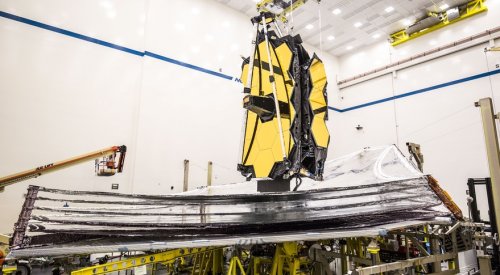HONOLULU — Despite a limited amount of schedule reserve remaining, both NASA and Northrop Grumman are cautiously optimistic that the James Webb Space Telescope will remain on schedule for launch in March 2021.
During a town hall about the mission during the 235th Meeting of the American Astronomical Society here Jan. 5, Eric Smith, program scientist for JWST at NASA Headquarters, told astronomers that work testing the giant space telescope was going well, even though only two months of margin remain in the schedule through its launch next year.
“Although the schedule margin looks a little tight up there,” he said, referring to a schedule chart for the mission, “we do remain within our budget and we are planning to the March 2021 launch readiness date.”
In interviews here Jan. 6, officials from both NASA and Northrop Grumman, the prime contractor for JWST, reiterated that confidence. “The path is to deliver the telescope by the end of 2020,” said Scott Willoughby, vice president and program manager for JWST at Northrop Grumman. The telescope will then be shipped from Northrop’s facilities in Southern California to Kourou, French Guiana, where it will be prepared for launch on an Ariane 5.
Workers are currently putting the telescope back into its folded launch configuration after recent deployment tests, as well as replacing two electronics units on the spacecraft that technicians found last year had failed. The spacecraft will then undergo vibration and acoustics tests to simulate the launch environment.
Those tests will be followed by a final set of deployments of the spacecraft’s sunshield. There will also be tests to confirm the ability to command the spacecraft from JWST’s mission operations center at the Space Telescope Science Institute in Maryland. That will be followed by “final configuration” of the spacecraft to prepare it for shipment to the launch site.
Willoughby said his confidence was based on the fact that many of the remaining tests, including deployments and environmental testing, have been done before. “All of the work that’s planned in front of us is very well understood,” he said. “If everything goes as planned, the schedule is very much sufficient to get us there.”
He also credited the progress the company made on JWST in the last year. “2019 was as successful of a year on this program as you probably could have imagined in the history of it,” he said. “I think that’s a great foretelling of 2020.”
Greg Robinson, the JWST program director at NASA Headquarters, is also optimistic about staying on schedule. “Hopefully by the end of the year we’ll take this baby over to Long Beach and put it on a boat and send it to Kourou,” he said in a separate interview.
Robinson acknowledged that schedule is the primary concern for JWST at this point, and that the schedule will be reassessed in May prior to the final set of environmental tests. NASA also has to inform the European Space Agency about 12 months in advance of the launch so that it can begin its launch preparations, but Robinson said that formal notice doesn’t have to come exactly a year before the launch, and that ESA is being kept in the loop about NASA’s plans.
Last year, Tom Young, the retired aerospace executive who chaired the independent review board that examined JWST, warned that the it appeared the program was consuming schedule margin at a high rate. Robinson said that, since then, the use of schedule margin has declined.
“In the second half of 2019, schedule erosion has diminished significantly, and that’s what gives us a lot of confidence to still press to that March 2021 launch date,” he said.
Robinson also said there were “no major concerns” about the budget for the mission. JWST received $423 million in the fiscal year 2020 spending bill enacted last month, and he said the mission was comfortably within its revised cost cap of $8.8 billion.
As work on the spacecraft itself continues, preparations are underway for planning observations once in space. The Space Telescope Science Institute, which will manage JWST operations, plans to release a “Cycle 1” call for proposals Jan. 23. Proposals will be due May 1, with the institute making selections later in the summer.
At the town hall meeting, institute officials said they expect to receive 1,000 to 1,600 proposals, seeking some fraction of the 6,000 hours of observing time that will be available in that initial round of observations. About 300 proposals will be selected for Cycle 1, which will begin once spacecraft commissioning is complete about six months after launch.
- Crunch time: Rocket companies in all-out battle for Air Force award
- The long road to Vostochny: Inside Russia’s newest launch facility
- The future of space-based astronomy may depend on two large ground-based telescopes
- Why Sierra Nevada’s owners are betting big on Dream Chaser
- The James Webb Space Telescope finally takes shape
Share with your friends

(0) Comments
This article comments are currently no :(